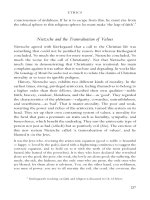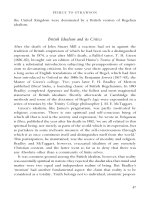Philosophy in the modern world a new history of western philosophy, volume 4 (new history of western philosophy) ( PDFDrive ) (1) 206
Bạn đang xem bản rút gọn của tài liệu. Xem và tải ngay bản đầy đủ của tài liệu tại đây (22.65 KB, 1 trang )
METAPHYSICS
Brown Book, where sections 58–67 are devoted to various language-games
with the word ‘can’. The distinctions that he draws between processes and
states, and between different kinds of states, correspond to the Aristotelian
distinctions between kinesis, hexis, and energeia. The criteria by which the two
philosophers make the distinctions often coincide. The example that Wittgenstein discusses at length, to illustrate the relation between a power and its
exercise, namely learning to read (PI i. 156 ff.), is close to the standard
Aristotelian example of a mental hexis, namely, knowledge of grammar. We
may call the systematic study of actuality and potentiality dynamic metaphysics,
and if we do so we must say that Wittgenstein was one of the most
consummate practitioners of that particular form of metaphysics.
It was not an Aristotelian type, however, but a Leibnizian one, that
turned out to be the most flourishing version of metaphysics in the latter
half of the twentieth century. The development of modal semantics in
terms of possible worlds5 need not, in itself, have had metaphysical implications, but a number of philosophers interpreted it in a metaphysical sense
and were prepared to countenance the idea that there were identifiable
individuals that had only possible and not actual existence.
In my view, this was a mistaken development. There is a difficulty in
providing a criterion of identity for merely possible objects. If something is
to be a subject of which we can make predications, it is essential that it shall
be possible to tell in what circumstances two predications are made of that
same subject. Otherwise we shall never be able to apply the principle that
contradictory predications should not be made of the same subject. We
have various complicated criteria by which we decide whether two statements are being made about the same actual man; by what criteria can we
decide whether two statements are being made about the same possible man?
These difficulties were entertainingly brought out by Quine in his famous
paper ‘On What There Is’ of 1961:
Take, for instance, the possible fat man in that doorway; and again, the possible
bald man in that doorway. Are they the same possible man, or two possible men?
How do we decide? How many possible men are there in that doorway? Are there
more possible thin ones than fat ones? How many of them are alike? Are no two
possible things alike? Is this the same as saying that it is impossible for two things to
5 See p. 119 above.
189









